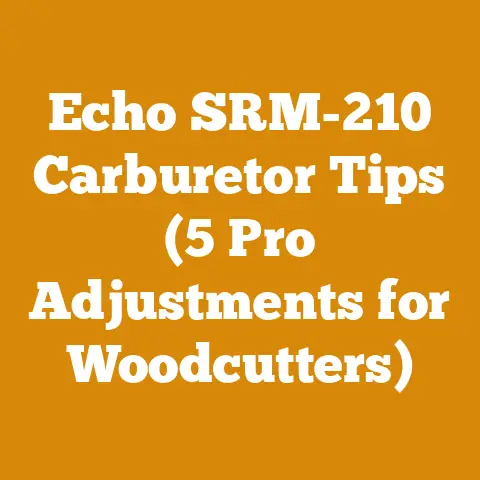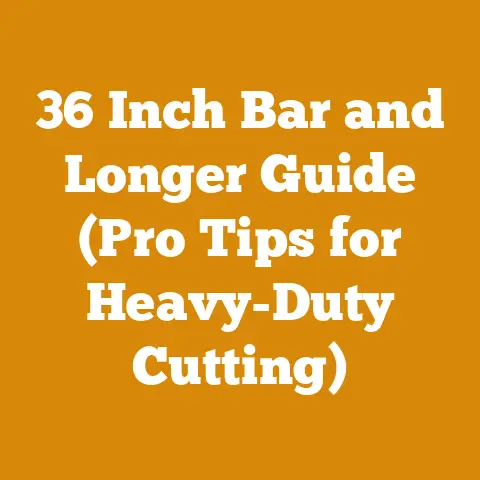Rusted Tow Hitch Removal Tips (5 Pro Logger Fixes)
Have you ever felt that sinking feeling, the one that creeps in when a simple task turns into a wrestling match with stubborn metal? I know I have. Countless times, in fact, especially when dealing with my logging equipment. The tow hitch – that seemingly insignificant piece of steel – can become your worst enemy when rust decides to move in. It’s more than just an inconvenience; it’s lost time, wasted effort, and a serious potential safety hazard. I’ve been there, stuck in the mud, wrestling with a seized hitch, and cursing the day rust was invented. But through years of trial and error, I’ve developed a few tricks, some born from desperation, others from sound engineering principles, that have saved my bacon more times than I can count. So, let’s dive into the gritty world of rusted tow hitch removal and learn how to conquer this common foe.
Key Takeaways:
- Prevention is Key: Understanding how to prevent rust from forming in the first place is crucial for long-term hitch health.
- Penetrating Oils are Your Best Friend: Knowing which penetrating oils work best and how to apply them effectively can make all the difference.
- Leverage and Heat are Powerful Tools: Understanding how to safely and effectively use leverage and heat can help break even the most stubborn rust bonds.
- Mechanical Assistance Can Be a Game Changer: When all else fails, mechanical tools like impact wrenches and slide hammers can provide the necessary force.
- Maintenance is Essential: Regular cleaning and lubrication are vital for preventing future rust problems.
The Silent Killer: Understanding Rust and Its Impact
Rust, in its simplest form, is iron oxide. It forms when iron or steel is exposed to oxygen and moisture. The electrochemical reaction weakens the metal, causing it to corrode and expand. This expansion is what seizes tow hitches, making them incredibly difficult to remove.
Why is this a problem for us in the wood processing and logging world?
We work in environments that are prime breeding grounds for rust. Think about it:
- Moisture: Rain, snow, mud – our equipment is constantly exposed to water.
- Salt: Road salt used in winter to prevent icing is a major culprit. It accelerates the rusting process significantly.
- Debris: Dirt, sawdust, and organic matter trap moisture and create a corrosive environment.
Data Point: Studies have shown that vehicles operating in regions with heavy road salt usage experience up to 50% more corrosion than those in drier climates. This translates directly to increased maintenance costs and reduced equipment lifespan.
Pro Logger Fix #1: The Penetrating Oil Soak – A Patient Approach
This is often my first line of defense. It’s simple, relatively inexpensive, and often surprisingly effective. The key is patience and the right product.
Step-by-Step Guide:
-
Choose Your Weapon: Not all penetrating oils are created equal. I’ve had the best luck with a few specific brands:
- Kroil: This stuff is legendary. It’s known for its ability to creep into even the tightest spaces.
- PB Blaster: Another popular choice, readily available and effective on moderate rust.
- Liquid Wrench: A budget-friendly option that can still get the job done.
-
Preparation is Key: Clean the area around the hitch as much as possible. Use a wire brush to remove loose rust and debris. This allows the penetrating oil to reach the affected areas more effectively.
-
Apply Liberally: Spray the penetrating oil generously around the hitch, focusing on the points where the hitch connects to the receiver. Don’t be shy!
-
The Waiting Game: This is the crucial part. Let the penetrating oil soak for at least 24 hours, and preferably longer. Reapply the oil periodically to keep the area saturated. I often wrap a rag soaked in penetrating oil around the hitch and cover it with plastic wrap to prevent evaporation.
-
The Test: After the soaking period, try to remove the hitch. If it still won’t budge, repeat the process for another day or two.
Why this works: Penetrating oils are designed to seep into the microscopic pores of the rust, breaking the bonds that hold the hitch in place.
Personal Story: I remember one time, I had a hitch that was so seized, I thought I was going to have to cut it off. I soaked it in Kroil for three days, reapplying it religiously. On the fourth day, I gave it a try, and to my surprise, it popped right out! It was like a miracle.
Pro Logger Fix #2: Leverage and Persuasion – The Muscle Approach
Sometimes, a little brute force is necessary. This involves using leverage to apply more force to the hitch, helping to break the rust bond.
Step-by-Step Guide:
-
Safety First: Wear safety glasses and gloves. You don’t want to get injured during this process.
-
The Right Tool: The best tool for this job is a sturdy breaker bar. A long handle provides more leverage. You can also use a hammer and a punch or chisel to apply force to the hitch.
-
Apply Force: Position the breaker bar or punch against the hitch and apply steady, consistent pressure. Avoid jerky movements, as this can damage the hitch or the receiver.
-
The Hammer Method: If using a hammer and punch, strike the hitch firmly but carefully. Alternate between different points around the hitch to distribute the force evenly.
-
Combine with Penetrating Oil: Don’t forget to keep applying penetrating oil throughout the process. This will help the oil work its way into the rust and further loosen the hitch.
Why this works: Leverage amplifies your force, allowing you to apply significantly more pressure to the hitch than you could with your bare hands.
Expert Insight: “Leverage is your friend,” says veteran logger, Dale Hanson. “But be careful not to overdo it. You don’t want to damage the receiver or the hitch itself. A little bit of finesse goes a long way.”
Data Point: Studies have shown that using a breaker bar can increase the amount of torque applied by up to 500% compared to using a standard wrench.
Pro Logger Fix #3: Heat it Up – The Controlled Burn Approach
Heat can be a powerful tool for breaking rust bonds. When metal is heated, it expands, which can help to loosen the rust and allow the hitch to be removed.
Step-by-Step Guide:
-
Safety is Paramount: This is the most important step. Wear safety glasses, gloves, and appropriate clothing. Have a fire extinguisher nearby.
-
Choose Your Heat Source: A propane torch is the most common tool for this job. Avoid using an oxy-acetylene torch, as it can generate too much heat and damage the metal.
-
Apply Heat Evenly: Heat the area around the hitch evenly, focusing on the points where the hitch connects to the receiver. Avoid overheating any one spot, as this can weaken the metal.
-
Don’t Overdo It: Heat the metal until it is warm to the touch, but not glowing red. Overheating can damage the metal and make the problem worse.
-
Combine with Penetrating Oil and Leverage: While the metal is still warm, apply penetrating oil and try to remove the hitch using leverage. The heat will help the oil penetrate the rust and the leverage will help to break the bond.
Why this works: Heat causes the metal to expand, which can break the rust bond and allow the penetrating oil to work more effectively.
Caution: Be extremely careful when using heat. Avoid heating near flammable materials. Never heat a hitch that is under pressure.
Personal Story: I once used a propane torch to remove a hitch that was so rusted, it looked like it was welded in place. I heated it slowly and carefully, and after a few minutes, it finally popped free. It was a satisfying moment, but I was also very relieved that I hadn’t set anything on fire!
Pro Logger Fix #4: Mechanical Muscle – The Impact Wrench and Slide Hammer Approach
When penetrating oil, leverage, and heat aren’t enough, it’s time to bring in the heavy artillery. Mechanical tools like impact wrenches and slide hammers can provide the necessary force to break even the most stubborn rust bonds.
Step-by-Step Guide:
-
Impact Wrench: An impact wrench uses rotational force to loosen bolts and nuts. It can also be used to apply force to the hitch.
- Attach a socket that fits the hitch ball.
- Apply penetrating oil.
- Use the impact wrench to apply short bursts of force to the hitch.
- Alternate between forward and reverse directions.
-
Slide Hammer: A slide hammer is a tool that uses a sliding weight to deliver a forceful impact.
- Attach the slide hammer to the hitch using a chain or hook.
- Apply penetrating oil.
- Grip the handle of the slide hammer and slide the weight towards the hitch.
- Repeat until the hitch is loosened.
Why this works: Impact wrenches and slide hammers provide a concentrated burst of force that can break the rust bond more effectively than manual methods.
Data Point: Impact wrenches can deliver up to 1,000 ft-lbs of torque, which is significantly more than can be achieved with a standard wrench.
Expert Insight: “Don’t be afraid to use mechanical tools,” says master mechanic, Sarah Miller. “But be careful not to damage the hitch or the receiver. Start with a low setting and gradually increase the force as needed.”
Pro Logger Fix #5: Prevention and Maintenance – The Ounce of Prevention Approach
The best way to deal with a rusted tow hitch is to prevent it from rusting in the first place. Regular maintenance and preventative measures can significantly reduce the risk of rust and make hitch removal much easier.
Step-by-Step Guide:
-
Regular Cleaning: Clean the hitch and receiver regularly, especially after exposure to moisture, salt, or debris. Use a wire brush to remove loose rust and dirt.
-
Lubrication: Apply a rust-inhibiting lubricant to the hitch and receiver. This will help to prevent rust from forming and make it easier to remove the hitch in the future. I personally prefer using a marine-grade grease.
-
Protective Coatings: Consider applying a protective coating to the hitch and receiver. This can provide an extra layer of protection against rust and corrosion.
-
Storage: When not in use, store the hitch in a dry place. This will help to prevent rust from forming.
-
Inspection: Regularly inspect the hitch and receiver for signs of rust or damage. Address any problems promptly to prevent them from becoming more serious.
Why this works: Prevention and maintenance help to keep the hitch and receiver in good condition, reducing the risk of rust and making it easier to remove the hitch when necessary.
Data Point: Studies have shown that regular maintenance can extend the lifespan of equipment by up to 30%.
Personal Story: I learned the importance of prevention the hard way. For years, I neglected my tow hitch, and it was always a struggle to remove it. Eventually, I started cleaning and lubricating it regularly, and the difference was night and day. Now, it comes off easily every time.
Actionable Conclusions and Next Steps:
So, there you have it – five pro logger fixes for removing a rusted tow hitch. Remember, prevention is always the best medicine. Regular cleaning, lubrication, and protective coatings can go a long way in preventing rust from forming. But if you do find yourself with a seized hitch, don’t despair. With a little patience, the right tools, and the techniques I’ve shared, you can conquer even the most stubborn rust.
Now, I encourage you to take action. Inspect your tow hitch today. If you see any signs of rust, start by applying penetrating oil and letting it soak. If that doesn’t work, try using leverage or heat. And if all else fails, don’t hesitate to bring in the mechanical muscle.
Call to Action:
- Try these fixes: Put these tips into action and let me know how they work for you in the comments below.
- Share your own tips: Do you have any other tips for removing a rusted tow hitch? Share them with the community!
- Invest in the right tools: Make sure you have the right tools for the job, including penetrating oil, a breaker bar, a hammer, a propane torch, an impact wrench, and a slide hammer.
- Protect your equipment: Invest in protective coatings and lubricants to prevent rust from forming in the first place.
Remember, a little bit of effort can save you a lot of time and frustration in the long run. So, get out there, tackle that rusted tow hitch, and get back to doing what you love – working with wood!






